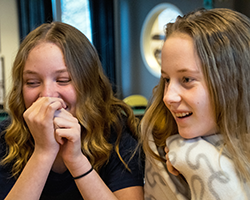International Youth Day: Safe spaces for healthy adolescents

WHO/Malin Bring
On 12 August, the world marks International Youth Day, with “safe spaces for youth” as the theme of this year’s celebration. It emphasizes the need to create places for youth to thrive, express themselves and feel comfortable. Safe spaces for young people can be civic, public or digital, as long as they ensure youth’s dignity and safety.
In keeping with the 2030 Agenda for Sustainable Development, creating safe and sustainable communities for young people (Goal 11) will contribute to improving their general health and well-being (Goal 3). Moreover, ensuring that these safe spaces are inclusive will empower youth to contribute to peace, global development and social cohesion (Goal 16).
Today, young people in the WHO European Region are healthier than ever before; however, many challenges still remain. For example, the Region includes countries with the highest adolescent suicide rates in the world. Thus, ensuring safe spaces during this important period of change is a critical step towards creating positive experiences for youth that encourage healthy lifestyles.
Supportive spaces for mental well-being
About half of all mental health problems in adulthood have their onset during or before adolescence, making this a critical time in young people’s development. According to the latest Health Behaviour in School-aged Children (HBSC) study, mental well-being declines as young people in the European Region move through adolescence.
Girls tend to report lower levels of perceived health, lower life satisfaction and more frequent health complaints than boys. Thus, 34% of 15-year-old girls across Europe feel nervous or stressed more than once a week compared with 19% of boys. Gendered patterns in self-rated health and well-being are worth considering when discussing safe spaces for youth.
Another fundamental factor that contributes to youth’s mental health is peer support. A major part of peer socialization during adolescence happens within a school context, where a positive experience has been identified as a protective factor against multiple health complaints.
In contrast, factors associated with poor mental health include bullying, lack of acceptance by peers and lack of support from teachers. The HBSC study shows that 34% of 11-year-old boys and 24% of 15-year-old boys have been bullied at least once in the past couple of months, with the figures slightly lower for girls. Spaces for peer communication free of pressure and bullying (including cyber-bullying) consequently provide many health benefits for youth.
Active spaces away from risky behaviour
Supportive peer communities are important for youth; however, they come with their own set of challenges. Several studies have found an association between time spent with friends and risk behaviours, such as alcohol and substance abuse and risky sexual behaviours.
In the European Region:
- 1 in 10 15-year-old boys have been drunk by the age of 13 or younger, though results vary across countries;
- 25% of 15-year-olds have reported having sexual intercourse, but more than 30% in some countries are not using any form of contraception, resulting in sexually transmitted diseases and unintended pregnancies.
Safe spaces for youth must not only protect them from harm but also encourage them to lead an active lifestyle and make healthy choices. Communities that include physical and leisure activities tailored specifically to the needs of adolescents can help young people avoid risky behaviours, improve their health and well-being and achieve their full potential, with benefits for youth themselves, and society at large.



